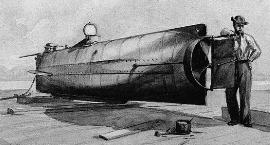Sinking of USS Housatonic
| Sinking of USS Housatonic | |||||||
|---|---|---|---|---|---|---|---|
| Part of the American Civil War | |||||||
 The Hunley by George S. Cook. |
|||||||
|
|||||||
| Belligerents | |||||||
|
|
|
||||||
| Commanders and leaders | |||||||
| Charles W. Pickering | George E. Dixon | ||||||
| Strength | |||||||
| 1 sloop-of-war | 1 submarine | ||||||
| Casualties and losses | |||||||
| 5 killed 1 sloop-of-war sunk |
none during attack, submarine sank shortly after attack with all hands | ||||||
The Sinking of USS Housatonic on 17 February 1864 during the American Civil War was an important turning point in naval warfare. The Confederate States Navy submarine, H.L. Hunley made her first and only attack on a Union Navy warship when she staged a clandestine night attack on the USS Housatonic in Charleston harbor. The Hunley approached just under the surface, avoiding detection until the last moments, then embedded and remotely detonated a spar torpedo that rapidly sank the 1,240 long tons (1,260 t) sloop-of-war with the loss of five Union sailors. The Hunley became renowned as the first submarine to successfully sink an enemy vessel in combat, and was the direct progenitor of what would eventually become international submarine warfare, although the victory was Pyrrhic and short-lived, since the submarine did not survive the attack and was lost with all eight Confederate crewmen.
On the evening of 17 February 1864, the Hunley made her first mission against an enemy vessel during the American Civil War. Armed with a spar torpedo, mounted to a rod extending out from her bow, the Hunley's mission was to lift the blockade of Charleston, South Carolina by destroying the sloop-of-war USS Housatonic in Charleston Harbor.
...
Wikipedia
